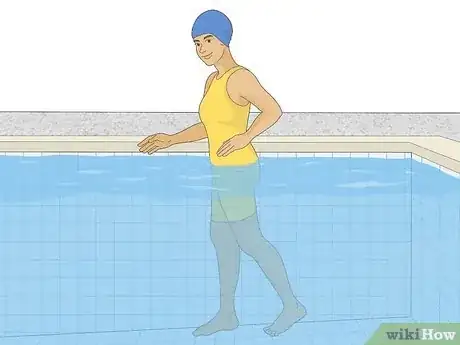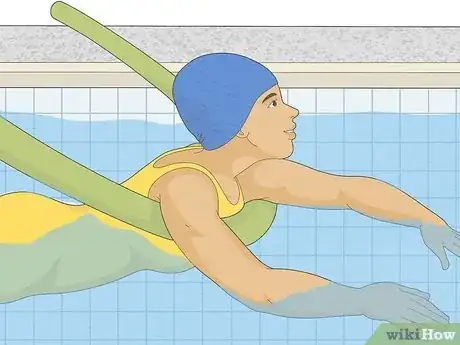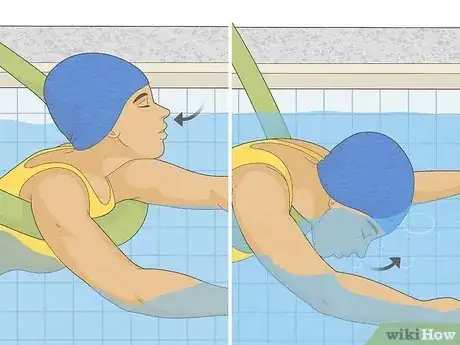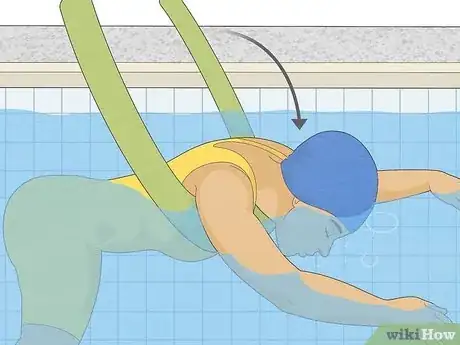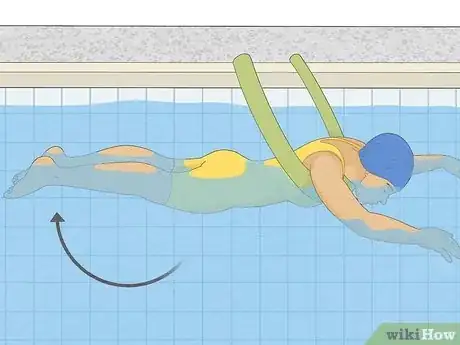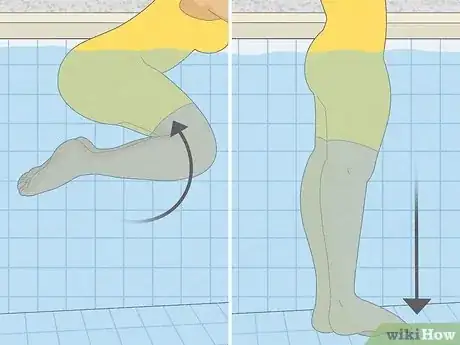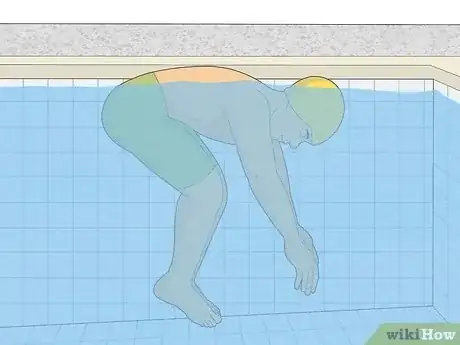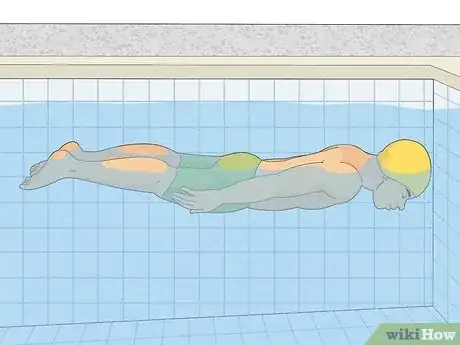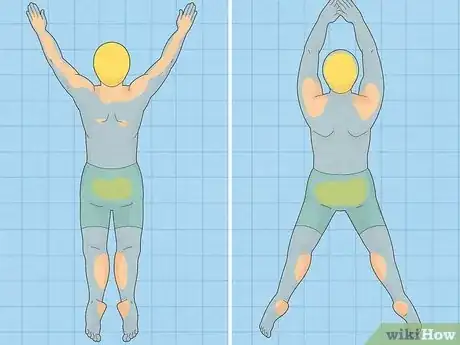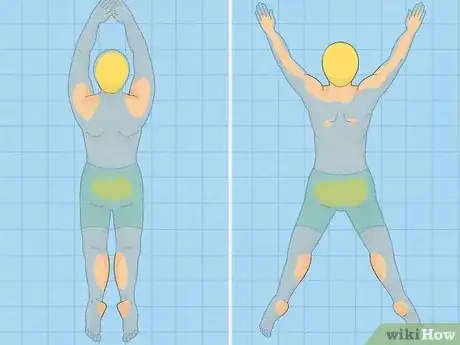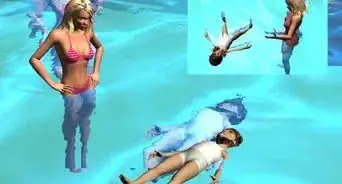This article was co-authored by Hayley Church and by wikiHow staff writer, Hannah Madden. Hayley Church is an owner at Cooksey's Lifeguard & Swim Academy, LLC in Southern California. Hayley has been a lifeguard and swim instructor since 2007 and has dedicated her time to teaching people of all ages how to swim. Hayley and her team offer lifeguards and programming such as swim camp counselors, swim lessons, and water aerobics classes to clients of all sizes from large organizations to private homes. She received her Master’s degree in Recreation Management.
There are 9 references cited in this article, which can be found at the bottom of the page.
This article has been viewed 17,921 times.
Nailing the front float is an important step in your swimming journey. Since it’s the foundation for so many other swim styles, like the breaststroke, the freestyle, and the butterfly, learning how to front float safely will allow you to learn many other swimming techniques. In this article, we’ll walk you through the correct front float technique, share some safety tips to help you feel comfortable and confident in the water, and give you ideas for what other floating techniques and drills you can try next.
Things You Should Know
- To front float, inhale deeply and push your face into the water. Let your legs float behind you as you look toward the floor of the pool.
- Front float safely by staying in the shallow end of the pool near a wall. Use flotation devices to help you stay afloat if you need to.
- Once you master the front float, try other floating techniques, like the jellyfish float and the I drill.
Steps
Front Float Technique
-
1Start in the shallow end of the pool near the wall. It’s much easier to practice your front float if you can quickly get your feet underneath you again. Head to the shallow end, and find a spot near the wall that you can grab onto if needed.[1]
- If you’re nervous or still new to swimming, ask a friend or family member to spot you while you practice your front float.
- Don’t feel comfortable in the water yet? Try dipping your toe in to get a feel for it. Walk into the pool slowly and calmly, going at your own pace.
-
2Hold a floatie or noodle in each hand for extra support. Foam floaties and pool noodles give you the buoyancy you need to stay afloat in the water. If you want extra help with your front float, hold a floatie or a noodle in each hand as you practice.[2]
- For even more support, put a floatation device underneath each armpit or your stomach. This will help support your upper body and let you relax a little more.
- Pool noodles can help you greatly with getting your body positions right in the water. You can use them either on your back or on your front to start floating.
- Pool noodles can give you a middle ground, without really bringing you up above the water. They keep you right on that surface level, which is great for float practice.
Advertisement -
3Inhale deeply, then press your face into the water. Take a deep breath in, then push your face underwater. You’ll notice that the air in your lungs helps keep you afloat. Keep holding your breath for about 15 seconds, or until you want to stand back up again.[3]
- If you’re new to swimming, try blowing bubbles while your face is underwater. You can do this by gently blowing the air out of your mouth.
-
4Bend forward until your face and upper body are in the water. Keep your chest, abdomen, and face pointed down towards the bottom of the pool as you transition into the front-float position. Don’t turn your head or body to the side.[4]
- If you’re wearing goggles, look down at the bottom of the pool and enjoy the view!
- You may also want to wear a nose clip to keep water out of your nose while you float face down.
- If you’re feeling nervous, hang onto the pool wall when you bend forward. That way, you’ll stay in the same spot and you can quickly pick your head up if you need to.
-
5Extend your legs straight behind you. As you hold your breath, gently lift your feet up off the floor and let them dangle behind you in the water. You’ll feel your hips start to rise toward the surface of the water, which is exactly what you want.[5]
- Keep your legs slightly open behind you.
-
6Tuck your knees and lift your face to stop floating. When you’re about to run out of breath, bring your legs in toward your chest to get them underneath you, then push your feet toward the floor. Lift your face out of the water to stand up in the pool again.[6]
- To get good at the front float, try practicing it 5 to 10 times in a row.
Front Float Variations and Drills
-
1Try the jellyfish float by letting your arms and legs dangle down. Start by standing waist-deep in the water, then take a deep breath and submerge yourself in the water. Allow your legs and arms to dangle down towards the bottom of the pool while you float. Relax and stay in this position for as long as you like.[7]
-
2Do the “I” drill to float with your body in a straight line. Stand waist deep in the water, take a deep breath, and then bend forward until your face is submerged. Let your legs float behind you and push your arms back by your sides. Hold this position while you float, and lift your head out of the water to breathe when you need to.[8]
- Some people find it difficult to keep their legs from sinking in this position. If that’s the case, focus on engaging your core to keep your body in a straight line.
-
3Alternate between extending your arms and legs into a “Y” shape. Stand in waist-deep water, take in a deep breath and bend down until your face is submerged in the water. Get into the “I” shape position, extend your arms outwards into a “Y” shape, then slowly bring them back to the “I” shape position. Next, keep your arms in the "I" shape position, extend your legs out into an inverted “Y” shape, and slowly bring them back into an “I” shape again.[9]
- Continue to alternate and float this way for as long as you like.
- Moving your arms and legs helps strengthen your core so you can front float better.
-
4Move your arms and legs simultaneously from an “I” to an “X” shape. Take a deep breath and submerge your face in the water as you lean into the front-float position. Move your legs and arms outwards at the same time so your body looks like an “X” from above. Then, bring your arms and legs back into an “I” shape at the same time.[10]
- Repeat this for as long as you like.
- This drill is similar to the “Y” drill, except you’ll be moving your arms and legs outwards and inwards at the same time instead of alternating them. This drill also helps strengthen your core and improve your front float.
Community Q&A
-
QuestionWhat if you run out of breath underwater and you’re not in the shallow end? How do you get up?
 wikiHow Staff EditorThis answer was written by one of our trained team of researchers who validated it for accuracy and comprehensiveness.
wikiHow Staff EditorThis answer was written by one of our trained team of researchers who validated it for accuracy and comprehensiveness.
Staff Answer wikiHow Staff EditorStaff AnswerWhen you're floating in the deep end of the pool, tuck your knees in toward your chest to propel your body upwards. Lift your face out of the water, then kick your arms and legs to tread water and stay afloat. From there, you can swim over to the side of the pool or back toward the shallow end.
wikiHow Staff EditorStaff AnswerWhen you're floating in the deep end of the pool, tuck your knees in toward your chest to propel your body upwards. Lift your face out of the water, then kick your arms and legs to tread water and stay afloat. From there, you can swim over to the side of the pool or back toward the shallow end.
Expert Interview

Thanks for reading our article! If you’d like to learn more about floating techniques, check out our in-depth interview with Hayley Church.
References
- ↑ https://www.youtube.com/watch?v=irSzTAFJpOs&t=189s
- ↑ https://www.fatherly.com/play/how-to-teach-kid-float-swimming-pool
- ↑ https://www.youtube.com/watch?v=OEmSQP7Pv-A&t=16s
- ↑ https://www.ymcamke.org/wp-content/uploads/2020/03/Front-Float.pdf
- ↑ https://www.youtube.com/watch?v=Pf8mGGRPiyM&t=16s
- ↑ https://www.youtube.com/watch?v=Pf8mGGRPiyM&t=34s
- ↑ https://www.ocnj.us/media/AnF%20Photos/Task%20Card-%20Floating%20and%20Gliding.pdf
- ↑ http://www.nataswim.info/blog/item/75-drills-for-freestyle-swimming
- ↑ https://www.breakwatersportstraining.com/mastery/front_float_drills.html
